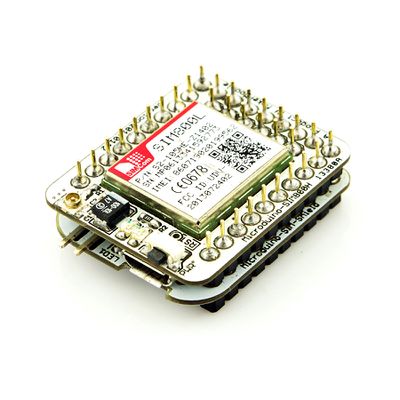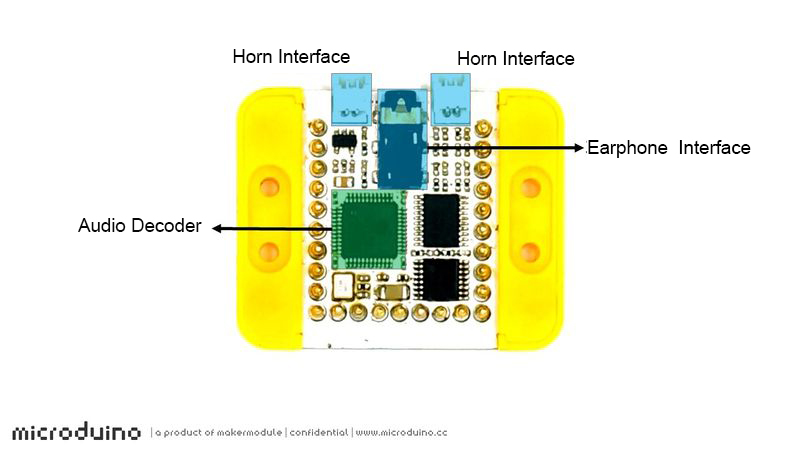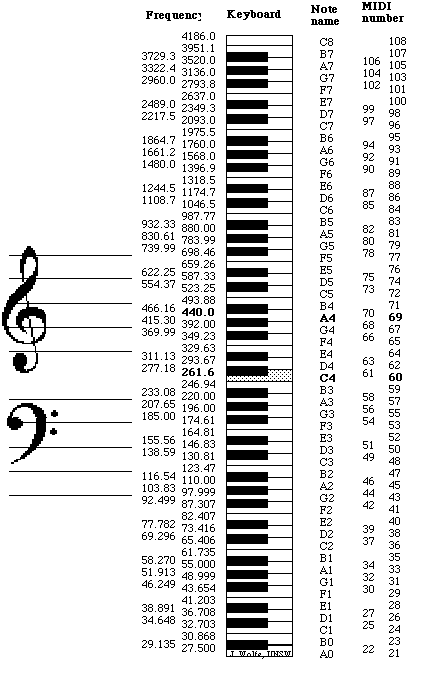“Microduino-Module AudioPro/zh”的版本间的差异
(→MIDI numbers,Note names and frequencies) |
(→附录) |
||
| 第93行: | 第93行: | ||
===MIDI numbers,Note names and frequencies=== | ===MIDI numbers,Note names and frequencies=== | ||
'''可参考:[http://newt.phys.unsw.edu.au/jw/notes.html NUSW]''' | '''可参考:[http://newt.phys.unsw.edu.au/jw/notes.html NUSW]''' | ||
| − | [[file:MIDIlist.gif|430px|thumb| | + | [[file:MIDIlist.gif|430px|thumb|left| MIDIlist]] |
| + | |||
| + | *This table is reproduced inverted below, i.e. with high pitch at the top. | ||
| + | *To convert from any frequency to pitch (i.e. to the nearest note and how far it is out of tune, go to the frequency to note converter written by Andrew Botros. | ||
| + | *How to do the caluation? Suppose thattwo notes have frequencies f1 and f2, and a frequency ratio of f2/f1. An octave is a ratio of 2:1, so the number of octaves between f2 and f1 is | ||
| + | **no = log2(f2/f1). | ||
| + | |||
| + | *Now to divide the octave into smaller units. In equal temperament, where all semitones have the same frequency ratio of 21/12, conversion between note name and frequency is simple. First, one needs a reference note and frequency. This is usually A4, which is often set at 440 Hz. For a note that lies n semitones higher (or −n semitones lower), the frequency is then | ||
| + | **fn = 2n/12*440 Hz. | ||
| + | |||
| + | *Conversely, one can obtain n, the number of semitones from A4, from | ||
| + | **n = 12*log2(fn/440 Hz). | ||
| + | |||
| + | *Similar equations give no, the number of octaves from A4, and nc, the number of cents from A4: | ||
| + | **no = log2(fn/440 Hz) and nc = 1200*log2(fn/440 Hz). | ||
| + | |||
| + | *In electronic music, pitch is often given by MIDI number: let's call it m for our purposes. m for the note A4 is 69 and increases by one for each equal tempered semitone, so this gives us a simple conversion between frequencies and MIDI numbers (again using 440 Hz as the pitch of A4): | ||
| + | **m = 12*log2(fm/440 Hz) + 69 and fm = 2(m−69)/12(440 Hz). | ||
| + | |||
| + | *The notation used here is not universal: in German speaking countries, H is used instead of B, and B is used for Bb. (This allowed Bach to write his name in the Art of Fugue.) And of course when different tuning systems are used, different names are applied. | ||
===MIDI旋律乐器组(GM1)=== | ===MIDI旋律乐器组(GM1)=== | ||
2016年5月6日 (五) 05:37的版本
| Language | English |
|---|
|
Microduino AudioPro是以VS1053为解码器,集成2.2W立体声功放,并且支持2.5mm立体声耳机接口的多功能音频模块,支持MIDI功能
目录特色
规格
引脚说明
文档
开发
应用问题解答历史图库文件:Microduino-AudioPro-B.JPG Microduino-AudioPro Front 视频附录MIDI numbers,Note names and frequencies可参考:NUSW
MIDI旋律乐器组(GM1)
MIDI打击乐器组(GM1+GM2)
|


